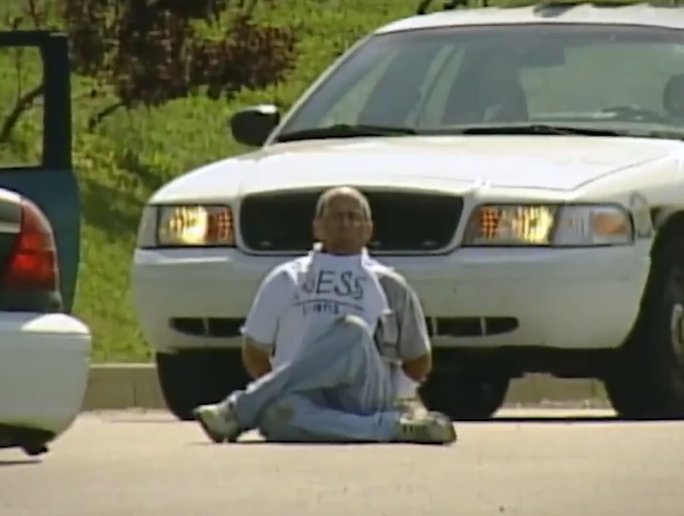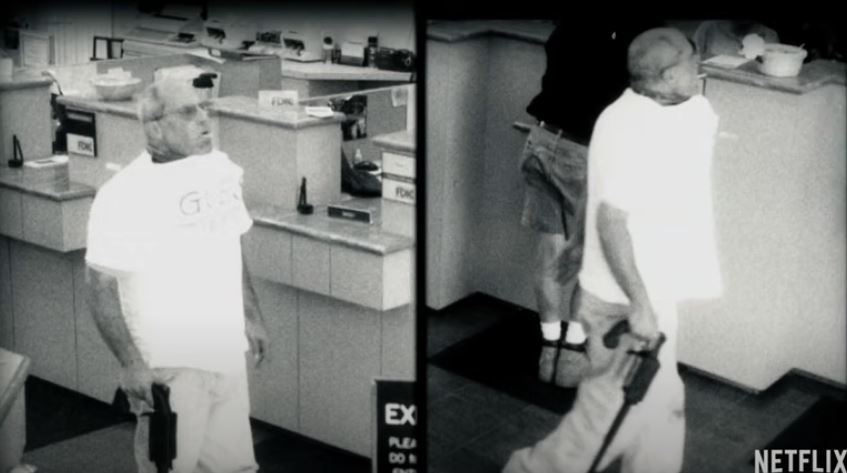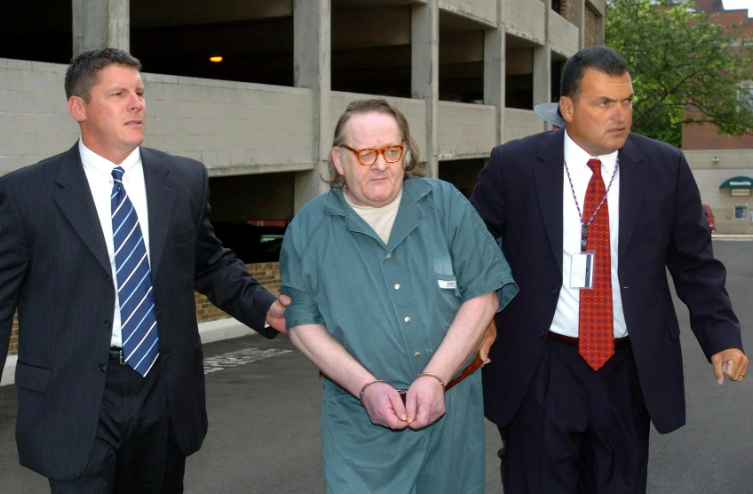A FORMER FBI agent revealed how the mastermind behind America’s most infamous bank heist tried to kill him after they shared pretzels and a Diet Coke.
With more than 30 years experience in law enforcement, Jerry Clark was the lead investigator of the collar bomb case in 2003.
Serial killer Marjorie Diehl-Armstrong orchestrated the robbery plot in Erie in Pennsylvania that led to the death of pizza delivery driver Brian Wells.
Marjorie wanted someone to rob $250,000 from a bank to get cash to pay someone to kill her father – who was allegedly “spending all her inheritance money”.
Her accomplices included William Rothstein, her former fiancé, and her friend Kenneth Barnes.
It took a team of investigators – led by Clark – more than seven years to unravel the bizarre case that shocked the world.
On August 28, 2003, Wells, 46, walked into a bank with a shotgun disguised as a cane and demanded $250,000 in cash.
A collar bomb was fastened around his neck and a note said it would explode if he didn’t get what he wanted.
Carrying a bag stuffed with more than $8,000, he calmly walked out before being surrounded by police.
Wells told cops he had been forced to wear the device and rob the bank – and news cameras were rolling when the bomb went off.
Cops later discovered detailed instructions in Wells’ car for the “Bomb Hostage” which contained codes to disable the explosive device.
But investigators concluded that the bomb – which had four locks and a combination dial – could never have been safely removed.
Three days after Wells’ grisly death, a second pizza delivery driver died of an overdose – after being an alleged witness to the crime.
And three weeks later, Rothstein told cops that Marjorie had killed her ex-boyfriend James Roden – and dumped his body in his freezer.
Investigators said Marjorie killed Roden because he knew about the bank heist and suggested he would inform the police.
Two decades on, former FBI agent Clark spoke to The Sun about the harrowing memories from his time in charge of the FBI major case.
He said Marjorie and Rothstein were two of the toughest criminals he has ever had to interview.
Before killing her ex-boyfriend Roden, Clark said serial killer Marjorie had killed at least five people – or was at least responsible for their deaths.
He spoke to her a total of eight times while she was serving time for the murder of Roden.
“I know for a fact that when I interviewed Marjorie Diehl-Armstrong, I had never met somebody like her,” he said.
“You may get a person like that once in a lifetime as an investigator to get to interview, and I had the chance to interview her multiple times.”
The last time Clark and Marjorie spoke was on May 10, 2006.
The FBI agent took her on a ride in Summit Township, Erie, where she pointed out her whereabouts on the day Wells was killed.
“Marjorie was more challenging because she was more calculated and always trying to out-think me,” Clark said.
“We’re in the back seat of a police car, driving her around and she’s showing us different things.
“One moment we’re laughing and having pretzel rods and Diet Cokes, but then when I take her back to the prison, she immediately tries to get her cellmate to hire her boyfriend to kill me.”
Marjorie was more challenging because she was more calculated and always trying to out-think me
Jerry Clark
He added: “It shows you how manipulative and diabolical she really was.
“Here she’s laughing with me and joking and then trying to kill me 10 minutes later.”
When interviewing Rothstein, Clark said he “never got enough credit for how evil he was”.
“He loses out to Marjorie for being this mastermind, but quite honestly, Bill came up with the bank robbery, the scheme, the device, the scavenger hunt, the notes, the cane gun,” he explained.
“Rothstein was a narcissist and had a true antisocial personality disorder.
“And that’s why he wanted to make such an overly-complicated plot – to feed his ego.”
“He thought he was smarter than everybody and had to tell me how intelligent he was.
“When we met I told him ‘Hey, Bill, I’m Jerry Clark, I’m here to interview you’.
“He replied: ‘I need to tell you I’m the smartest guy in this room’.”
Clark explained that Rothstein was dying of cancer at the time, so he thought he’d go out with this “perfect plan”.
“It turned out to be the worst bank robbery you could ever do, but in his mind, it was the best plan,” the ex-FBI agent said.
“He wanted to leave Erie with this big mystery, but he failed at doing so thanks to the good investigative work by the whole team.
“Investigators never, ever gave up. I’m just so proud of the fact that we finished it and got the people involved.”
What began as a bizarre collar bomb bank heist quickly escalated into notoriety as one of FBI’s major cases – a special category for infamous crimes and incidents, such as 9/11.
Clark compared the case to “when Kennedy was shot, but in our own small world version”.
“Something like this had never happened in the history of the FBI,” Clark said.
“You had three deceased people within three weeks, and my job as the FBI agent in charge was to link all three of those cases into one scheme.
“That was definitely the most complex part of it all.
“It was not just the bank robbery, it was the killing of witnesses, which is the second pizza delivery driver.
“And it’s the killing of a person that was going to turn them in, which is the guy who ended up in the freezer.
“The whole thing was really unbelievable as a scheme.”
Marjorie was eventually sentenced to life in prison for armed bank robbery, conspiracy and using a destructive device in a crime of violence.
She died in 2017 aged 68 from breast cancer in a Texas prison.
Rothstein was named as a co-conspirator, and died of cancer in 2004 aged 60.
The pizza bomber plot was turned into a four-part Netflix doc titled Evil Genius, in which Clark was featured.
But the FBI agent pointed out the single “mistake” made by producers in the hit true crime series.
“Netflix was very well done up until the very last segment,” Clark said.
“Producers tried to indicate that Brian Wells did not know these people and was not involved whatsoever.
“But the evidence says Brian Wells met these people.”
He explained: “They convinced them to go to a pre-planning meeting the day before, rob the bank, and it would be a fake device that would not go off.
“And that’s why he was pretty calm for a guy that had a collar bomb around his neck and left the bank with a lollipop. So that’s the only part that Netflix veers at the end on.
“There’s no doubt he knew, he just didn’t know he was dying that day and that they were purposely trying to kill him.”
Clark – a fellow Erie resident – opened up about the main challenges of dealing with one of America’s most diabolical crimes with his hometown being the haunting backdrop.
“I was on a violent crime squad, so I’d seen different ways you can die – certainly shootings, stabbings and drownings – but I had never seen the detonation of a bomb attached to the human body before,” he revealed.
“So that lived with me for a long time because I still go by that road every day.
“On September 21, 2003, opening up a freezer and seeing a dead body in there was one of the many things that stick with me to this day and really played hard on me personally.
“I’ve become totally enmeshed in this investigation. It’s in the fabric of my life now.”
The collar bomb case: the complete timeline
The pizza bomber case took more than seven years to investigate and prosecute.
August 28, 2003: Brian Wells is killed when a bomb locked to his neck explodes after he robs the PNC Bank in Erie, Pennsylvania.
Wells tells state police before the collar bomb goes off that four black men forced him to wear the device and rob the bank.
Investigators later determine Wells was lying.
That same night, federal agents search Wells’ house on Loveland Avenue in Millcreek Township.
They find nothing to indicate the collar bomb was built there.
August 31, 2003: Robert Pinetti, Wells’ friend and co-worker, dies from what is ruled an accidental drug overdose.
September 13, 2003: William A. Rothstein, Marjorie Diehl-Armstrong’s ex fiancé, dumps 1,040 pounds of debris at Lake View Landfill.
September 20, 2003: Rothstein calls 911 to report that the body of James Roden, Diehl-Armstrong’s boyfriend, is in a freezer in Rothstein’s garage. He blames Diehl-Armstrong.
September 21, 2003: Cops charge Diehl-Armstrong in Roden’s death.
They allege she fatally shot him at her East Seventh Street house, in Erie, sometime before August 28, then helped move the body to Rothstein’s house in upper Peach Street.
September 24, 2003: Police and federal agents question Rothstein about the Wells case.
He says he may have used the pay phone that was the source of the final phone call to Wells.
March 2004: Diehl-Armstrong, who suffers from bipolar disorder, is transferred from Erie County Prison to Mayview State Hospital, near Pittsburgh, for a long-term psychiatric evaluation in the Roden case.
She is off limits to investigators while at Mayview because of her mental state.
July 30, 2004: Rothstein dies of cancer, aged 60.
He says nothing about the Wells case to investigators, who question him on his deathbed.
January 7, 2005: Diehl-Armstrong pleads guilty but mentally ill to third-degree murder in Roden’s death in Erie County Court.
She is sentenced up to 20 years in a state prison.
March 16, 2005: Diehl-Armstrong is transferred from Mayview to the State Correctional Institution at Muncy.
April 20 and May 23, 2005: Jerry Clark interviews Diehl-Armstrong.
She talks about Rothstein but refuses to answer questions.
July 5, 2005: Clark interviews Diehl-Armstrong at the state prison at Cambridge Springs.
According to the FBI, she says she killed Roden to silence him in the Wells plot, and added she never spoke in detail about his killing because she feared it would implicate her in the Wells case.
In the summer of 2003, she says she gave Rothstein kitchen timers — integral components to the collar bomb — and was a quarter of a mile from the bank robbery site when Wells was killed.
July 19 and 20, 2005: Clark interviews Floyd A. Stockton Jr. – Rothstein’s housemate at the time Wells was killed.
He says Rothstein and Diehl-Armstrong were involved in the bank-robbery and bomb plot because they needed money.
August and September, 2005: Clark interviews Kenneth E. Barnes, Diehl-Armstrong’s fishing pal.
Before Wells’ death, Barnes says Diehl-Armstrong asked him to kill her father to stop him from spending her inheritance.
December 2005: Barnes meets with Clark.
He says he, Diehl-Armstrong, Rothstein, Stockton and Wells met on August 27, 2003, to review the bank robbery plot.
Barnes says he and Diehl-Armstrong watched Wells through binoculars before he was killed.
February 10, 2006: Wick and Clark meet with Diehl-Armstrong.
She gets upset when told of Barnes’ comments and denies being with him on August 27 and 28, 2003. She claims Rothstein framed her.
February 14, 2006: Clark and Wick meet with Barnes.
He gets upset when told of Diehl-Armstrong’s denials, calling her a liar.
May 10, 2006: Diehl-Armstrong would talk to Clark a total of eight times – this being the date of her last interview.
Along with her lawyer who encouraged her to talk, she goes on a ride with Clark in Summit Township.
She points out where she was throughout the day when Wells was killed, according to the FBI.
July 9, 2007: A federal grand jury indicts Diehl-Armstrong and Barnes on the felonies of armed bank robbery, conspiracy to commit armed bank robbery and using a destructive device in a crime of violence.
The grand jury also names Wells and Rothstein as unindicted co-conspirators.
July 29, 2008: U.S. District Judge Sean J. McLaughlin rules Diehl-Armstrong incompetent for trial, largely because of her bipolar disorder. He orders her to undergo more mental-health exams in the federal prison system.
September 3, 2008: Barnes pleads guilty before McLaughlin to conspiracy to commit bank robbery as well as using a destructive device during a crime of violence, both felonies.
December 3, 2008: McLaughlin sentences Barnes, then 54, to 45 years in federal prison. He agrees to testify against Diehl-Armstrong.
September 8, 2009: McLaughlin finds Diehl-Armstrong competent to stand trial.
March 2010: Diehl-Armstrong has a cancerous lump removed from her neck, and is later diagnosed with glandular cancer that originated in one of her breasts.
August 12, 2010: At a court hearing, McLaughlin reviews a physician’s report that gives Diehl-Armstrong three to seven years to live.
The prosecutor, Assistant U.S. Attorney Marshall Piccinini, says he plans to proceed with the trial.
He says he would have considered halting the trial if the medical report had given Diehl-Armstrong less time to live.
McLaughlin sets a trial date for October 12.
October 12, 2010: Jury selection begins in Diehl-Armstrong’s trial.
November 1, 2010: After deliberating 11 hours and 30 minutes over two days, the jury finds Diehl-Armstrong guilty of armed bank robbery, conspiracy and using a destructive device in a crime of violence.
February 28, 2011: McLaughlin sentences Diehl-Armstrong to life in prison, plus 30 years. The federal prison system has no parole.
April 4, 2017: Marjorie Diehl-Armstrong dies at Federal Medical Center in Texas aged 68.
She had been serving her prison sentence for the pizza bomber plot.






